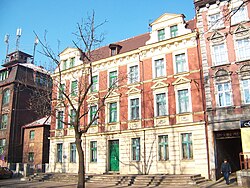
Środa Wielkopolska is a town in western-central Poland, situated in the Greater Poland Voivodeship, about 30 kilometres (19 mi) southeast of Poznań, with 22,001 inhabitants (2009). It is the seat of Środa Wielkopolska County, and of Gmina Środa Wielkopolska.

Goczałkowice-Zdrój is a village in Pszczyna County, Silesian Voivodeship, in southern Poland. It is the seat of the gmina called Gmina Goczałkowice-Zdrój. It lies approximately 6 kilometres (4 mi) south of Pszczyna and 36 km (22 mi) south of the regional capital Katowice. The gmina covers an area of 48.64 square kilometres (18.8 sq mi), and as of 2006 the population of the village and gmina is 6,263.

Wirek is a district in the centre of Ruda Śląska, Silesian Voivodeship, southern Poland. In 2006 it had an area of 5.9 km2 and was inhabited by 20,595 people. On January 12, 2006 a part of it was split off to form a new district, Czarny Las.

Niedobczyce is a district of Rybnik, Silesian Voivodeship, southern Poland. Between 1955 and 1975 it was an independent town On December 31, 2013 it had about 12,300 inhabitants.
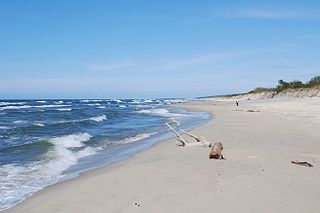
Nowa Karczma is a neighborhood of Krynica Morska on the Vistula Spit in northern Poland, located in the eastern part of the town.

Halemba is a district in the south-west of Ruda Śląska, Silesian Voivodeship, southern Poland. It lies on the river Kłodnica, right tritubary of Odra. It has an area of 19.6 km2 and in 2006 it was inhabited by 26,080 people.

Kochłowice is a district in the south-east of Ruda Śląska, Silesian Voivodeship, southern Poland. It has an area of 17.5 km2 and in 2006 it was inhabited by 12,738 people.
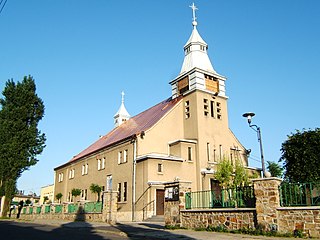
Bykowina is a district in the south-east of Ruda Śląska, Silesian Voivodeship, southern Poland. It has an area of 1.6 km2 and in 2006 it was inhabited by 18,267 people.

Wilkowyje is a dzielnica (district) of Tychy, Silesian Voivodeship, southern Poland. It was an independent village and a seat of gmina, which was absorbed by Tychy in 1951.
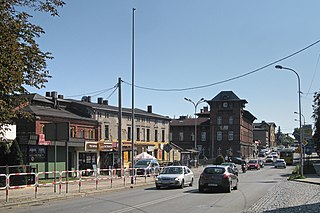
Brzezinka is a dzielnica (district) of Mysłowice, Silesian Voivodeship, southern Poland. It was previously an independent village and gmina, but was absorbed by Mysłowice in 1951.

Brzęczkowice is a neighbourhood and a part of dzielnica (district) Brzęczkowice and Słupna, in Mysłowice, Silesian Voivodeship, southern Poland. It was previously an independent village and gmina, that was absorbed by Mysłowice in 1945 and again in 1951.

Dębieńsko is a dzielnica (district) of Czerwionka-Leszczyny, Silesian Voivodeship, southern Poland. It was an independent village, but became administratively part of Leszczyny in 1977, renamed to Czerwionka-Leszczyny in 1992. It has an area of 15,01 km2.
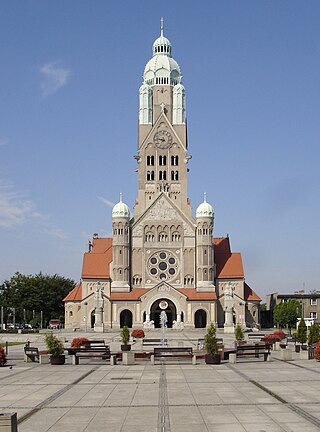
Nowy Bytom is a district serving as administrative centre of Ruda Śląska, Silesian Voivodeship, southern Poland. In 2006 it had an area of 4.6 km2 and was inhabited by 12,058 people. On January 12, 2006 a part of it was split off to form a new district, Czarny Las.

Chebzie is a district in the east of Ruda Śląska, Silesian Voivodeship, southern Poland. It has an area of 1.7 km2 and was inhabited by 1,101 people.

Chwałowice is a district of Rybnik, Silesian Voivodeship, southern Poland. On December 31, 2013 it had 7,700 inhabitants.

Boguszowice Stare is a district of Rybnik, Silesian Voivodeship, southern Poland. In the late 2013 it had about 7,700 inhabitants.

Niewiadom is a district of Rybnik, Silesian Voivodeship, southern Poland. In the late 2013 it had about 4,700 inhabitants.

Godula is a district in the north-east of Ruda Śląska, Silesian Voivodeship, southern Poland. It has an area of 1.8 km2 and in 2006 it was inhabited by 12,151 people.

Orzegów is a district in the north-east of Ruda Śląska, Silesian Voivodeship, southern Poland. It has an area of 2.5 km2 and in 2006 it was inhabited by 8,439 people.

Ruda is a district in the north-west of Ruda Śląska, Silesian Voivodeship, southern Poland. It has an area of 11.9 km2 and in 2006 it was inhabited by 23,134 people.
